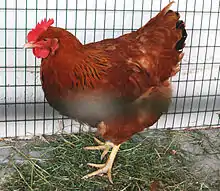New Hampshire chicken
The New Hampshire breed of chicken originated in the state of New Hampshire in the United States. Poultry farmers, starting with Rhode Island Reds and performing generation after generation of selective breeding, intensified the characteristics of early maturity, rapid full feathering, and production of large brown eggs. The mature birds are a rich chestnut red, of a somewhat lighter and more even shade than the Rhode Island Reds. The chicks are also a lighter red.
 | |
| Other names | New Hampshire Red |
|---|---|
| Country of origin | United States of America |
| Use | Dual-purpose breed |
| Traits | |
| Weight |
|
| Skin color | Yellow |
| Egg color | Brown |
| Comb type | Single |
| Classification | |
| APA | American[1] |
| ABA | Single comb, clean legged |
| PCGB | Soft feather: heavy[2] |
| |
History
The New Hampshire was developed in 1915 from a strain of Rhode Island Red brought into the state of New Hampshire. The breed was admitted to the American Standard of Perfection in 1935.[1] They represent a specialized selection out of the Rhode Island Red breed. By intensive selection for rapid growth, fast feathering, early maturity and vigor, a different breed gradually emerged. This took place in the New England states, chiefly in Massachusetts and New Hampshire, from which it takes its name.
In 2018, the breed was designated as the official State Poultry by the New Hampshire legislature after an appeal from fourth grade students at Canaan Elementary School.
Characteristics

They possess a deep, broad body, grow feathers very rapidly, are prone to go broody and make good mothers. Most pin feathers are a reddish, brownish buff in color and, therefore, do not detract from the carcass appearance very much. The color is a medium to light red and often fades in the sunshine. The comb is single and medium to large in size; in the females it often lops over a bit. While mainly raised for meat, they are also modest producers of brown eggs. Some strains lay eggs of a dark brown shell color. They are available in both standard and bantam varieties. Generally a docile breed. They were initially used in the Chicken of Tomorrow contests, which led the way for the modern broiler industry, and they were also used to develop the Delaware breed of chicken. A hen of this breed will lay about 240 large brown eggs a year. A full grown hen typically weighs 6.5 pounds (2.9 kg), while a full-grown rooster weighs approximately 8.5 pounds (3.9 kg). Pullets weigh around 5.5 pounds (2.5 kg), and cockrels will weigh about 7.5 pounds (3.4 kg). They are currently on watch status according to the American Livestock Breeds Conservancy (ALBC). Their preferred roost height is 2 to 4 feet (0.61 to 1.22 m).
It is a dual-purpose chicken, selected more for meat production than egg production. Medium heavy in weight, it dresses plump carcass used as either a broiler or a roaster.
References
- APA Recognized Breeds and Varieties: As of January 1, 2012. American Poultry Association. Archived 4 November 2017.
- Breed Classification. Poultry Club of Great Britain. Archived 12 June 2018.
- Chicken Breeds and Varieties (A2880), John L. Skinner, University of Wisconsin–Madison; Dr. Joe Berry, Department of Animal Science, Oklahoma State University
- Poultryhub.org Fancy Chicken Breeds - New Hampshire
- http://www.nhpr.org/post/new-hampshire-red-becomes-official-state-poultry
- https://www.cacklehatchery.com/new-hampshire.html